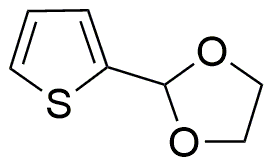2-(2-Thienyl)-1,3-dioxolane is widely utilized in research focused on:
- Pharmaceutical Development: This compound serves as a building block in the synthesis of various pharmaceuticals, particularly in the creation of drugs targeting neurological disorders due to its unique structural properties.
- Organic Synthesis: It is employed in organic synthesis as a versatile intermediate, allowing chemists to create complex molecules more efficiently, which is crucial in fields like agrochemicals and fine chemicals.
- Material Science: The compound is used in the development of novel materials, including polymers and coatings, that exhibit enhanced electrical and thermal properties, beneficial for electronics and automotive industries.
- Research in Catalysis: It plays a role in catalysis research, helping scientists to develop more effective catalysts for chemical reactions, which can lead to more sustainable manufacturing processes.
- Analytical Chemistry: This chemical is utilized in analytical methods to detect and quantify other compounds, making it valuable in environmental monitoring and quality control in manufacturing.
Informations générales
Propriétés
Sécurité et réglementation
Applications
2-(2-Thienyl)-1,3-dioxolane is widely utilized in research focused on:
- Pharmaceutical Development: This compound serves as a building block in the synthesis of various pharmaceuticals, particularly in the creation of drugs targeting neurological disorders due to its unique structural properties.
- Organic Synthesis: It is employed in organic synthesis as a versatile intermediate, allowing chemists to create complex molecules more efficiently, which is crucial in fields like agrochemicals and fine chemicals.
- Material Science: The compound is used in the development of novel materials, including polymers and coatings, that exhibit enhanced electrical and thermal properties, beneficial for electronics and automotive industries.
- Research in Catalysis: It plays a role in catalysis research, helping scientists to develop more effective catalysts for chemical reactions, which can lead to more sustainable manufacturing processes.
- Analytical Chemistry: This chemical is utilized in analytical methods to detect and quantify other compounds, making it valuable in environmental monitoring and quality control in manufacturing.
Documents
Fiches de données de sécurité (FDS)
La FDS fournit des informations de sécurité complètes sur la manipulation, le stockage et l’élimination du produit.
Spécifications du produit (PS)
Le PS fournit une description complète des propriétés du produit, notamment sa composition chimique, son état physique, sa pureté et les exigences de stockage. Il détaille également les plages de qualité acceptables et les applications prévues du produit.
Certificats d'analyse (COA)
Recherchez des certificats d'analyse (COA) en saisissant le numéro de lot du produit. Les numéros de lot et de lot se trouvent sur l'étiquette d'un produit, après les mots « Lot » ou « Lot de fabrication ».
Numéro de catalogue
Numéro de lot/série
Certificats d'origine (COO)
Ce certificat d'exploitation confirme le pays dans lequel le produit a été fabriqué, et détaille également les matériaux et composants utilisés et s'il est issu de sources naturelles, synthétiques ou autres sources spécifiques. Ce certificat peut être requis pour les douanes, le commerce et la conformité réglementaire.
Numéro de catalogue
Numéro de lot/série
Fiches de données de sécurité (FDS)
La FDS fournit des informations de sécurité complètes sur la manipulation, le stockage et l’élimination du produit.
DownloadSpécifications du produit (PS)
Le PS fournit une description complète des propriétés du produit, notamment sa composition chimique, son état physique, sa pureté et les exigences de stockage. Il détaille également les plages de qualité acceptables et les applications prévues du produit.
DownloadCertificats d'analyse (COA)
Recherchez des certificats d'analyse (COA) en saisissant le numéro de lot du produit. Les numéros de lot et de lot se trouvent sur l'étiquette d'un produit, après les mots « Lot » ou « Lot de fabrication ».
Numéro de catalogue
Numéro de lot/série
Certificats d'origine (COO)
Ce certificat d'exploitation confirme le pays dans lequel le produit a été fabriqué, et détaille également les matériaux et composants utilisés et s'il est issu de sources naturelles, synthétiques ou autres sources spécifiques. Ce certificat peut être requis pour les douanes, le commerce et la conformité réglementaire.


